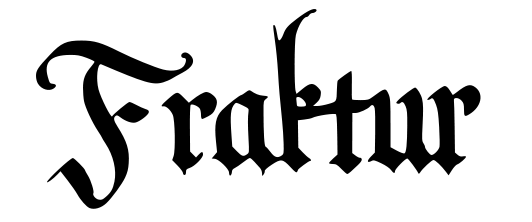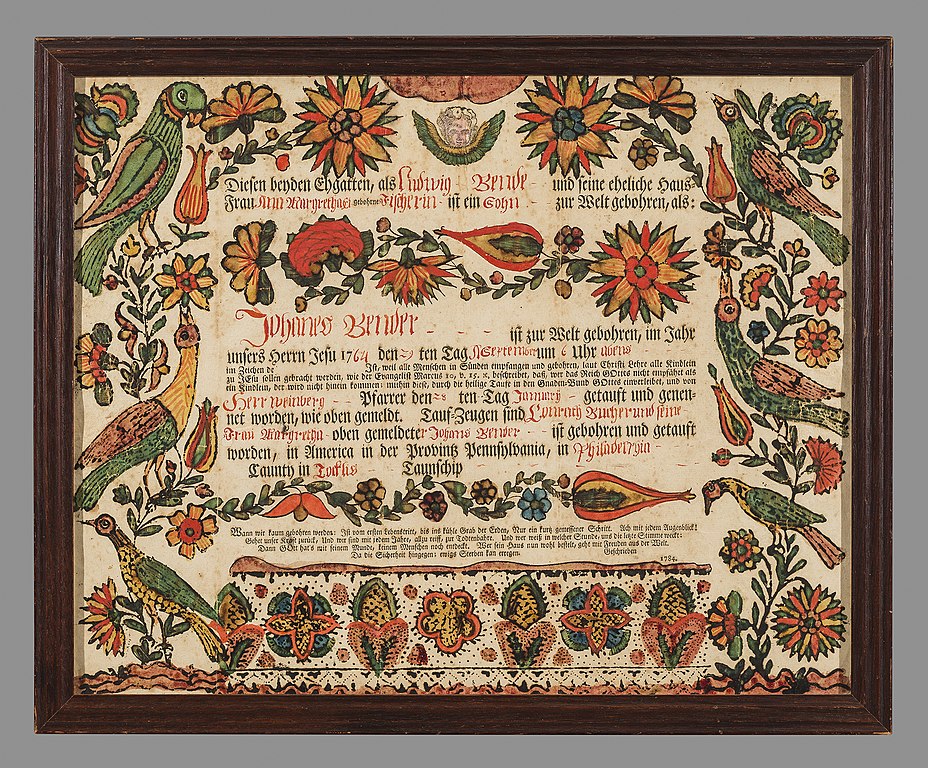The term Fraktur refers to a style of handwriting or typeface. The name for the lettering comes from the Latin word fractūra, meaning broken; as in the “broken” way in which the letters are formed as compared to other hand writing and type styles which contain more curves.
However, the Fraktur that will be examined in this blog post refers to folk-art certificates, these certificates use the Fraktur style of writing along with decoration. These Fraktur certificates were produced by the Pennsylvania Dutch. The Pennsylvania Dutch were the German speaking immigrants that settled in Pennsylvania in the 17th and 18th centuries. Many of these Pennsylvania Dutch later made their way into the Midwest.
The certificates of the Pennsylvania Dutch include baptismal certificates, birth records, marriage certificates and family registers. The most common of these certificates are the baptismal certificates, known as Taufschein/e, and birth records, known as Geburts Schein.
These Fraktur certificates of the Pennsylvania Dutch are part of the long history of illuminated texts that reaches back to the Middle Ages. The Fraktur records are personal ceremonial documents kept by the family, not an official vital record made by church or state. As a folk art, the first Frakturs were hand made by schoolmasters and clergymen. In later periods, the Frakturs included decorative printed certificates that the families could fill out with names and dates.
As the use of the German language or the Pennsylvania Dutch language decreased in later generations of Pennsylvania Dutch; the use of the Fraktur certificates also decreased.
Books and magazines about Fraktur in the Indiana State Library’s collection to explore:
“The Genealogist’s Guide to Fraktur : for genealogists researching German-American families,” call number: ISLG 929.13 E123GFR
Der Reggeboge. The Rainbow (magazine) Volume 54, 2020. Number 1 & 2 – Fraktur Fest, call number: ISLG 974.8 R154 v.54 #1/2
“Virginia Fraktur; Penmanship as Folk Art,” call number: ISLG 975.5 W973V
The Pennsylvania Dutchman (magazine), call number: ISLG 974.8 P415D
Pennsylvania Folklife (magazine), call number: ISLG 974.8 P415d
“Pennsylvania German Folk Art, by John Joseph Stoudt,” call number: G 974.8 P415pp v. 28 (currently in cataloging)
“Pennsylvania German Illuminated Manuscripts” by Henry Stauffer Borneman, call number: G 974.8 P415g v. 46 (currently in cataloging)
“The Heart of the Taufschein: Fraktur and the Pivotal Role of Berks County, Pennsylvania,” call number: ISLM GR110.P4 A372 v.46
Online sources about Fraktur to explore:
The Pennsylvania German style of illumination
This is the best online source of the history of Frakturs.
Revolutionary War Frakturs, the U.S. National Archives
Many widows sought to claim pensions from the government. These frakturs are those that were sent to the government to prove their relation to the deceased soldier and support the widows’ Revolutionary War pension applications.
Pennsylvania Folklife Vol. 28, No. 1
Article: “Taufscheine – A New Index for People Hunters,” page 29
Pennsylvania Folklife Vol. 28, No. 2
Article: “Taufscheine – A New Index for People Hunters – Part II,” page 36
The Pennsylvania Dutchman, Vol. 3 No. 10
Article: “Johann Valentin Schuller – Fractur Artist and Author.” An example of the types of articles you can find about Fraktur in the Pennsylvania Dutchman magazine.
Museum of Early Southern Decorative Arts
Collection: Fraktur
Pennsylvania German Broadsides and Fraktur
Penn State University, Rare Books and Manuscripts in the Special Collections Library
Pennsylvania German Fraktur and Manuscripts
Free Library of Philadelphia
Pennsylvania German Fraktur Collection
Franklin and Marshall College
Pennsylvania German fraktur, broadsides, and related drawings
Library of Congress
Ursinus College Fraktur Collection
This blog post is by Angi Porter, Genealogy Division librarian.



I have seen these certificates before but never paid much attention to them. They reminded me of “quilts” and I thought they were just somebody’s hobby. Thank you for expanding my brain!